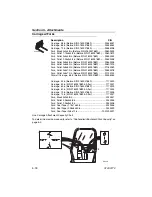
Section 5 - Attachments
5-4
31200172
5.4
USE OF THE CAPACITY CHART
To properly use the capacity chart (see page 5-6), the operator must first determine
and/or have the following:
1. An approved attachment. See
2. The proper Capacity Chart(s).
3. Weight of the load being lifted.
4. Load placement information:
a. HEIGHT where the load is to be placed.
b. DISTANCE from the front tires of the telehandler where the load is to be
placed.
5. On the Capacity Chart, find the line for the height and follow it over to the
distance.
6. The number in the load zone where the two cross is the maximum capacity for
this lift. If the two cross at a division between zones, the smaller number must
be used.
The number in the load zone must be equal to or greater than the weight of the load
to be lifted. Determine the limits of the load zone on the capacity chart and keep
within these limits.
Capacity Indicator Locations
OX0430
QU
E
B
H
R
R
O T
U
-10°
0°
10°
20°
30°
40
°
50
°
60
°
70
°
80
°
BOOM
EXTENSION
INDICATOR
BOOM ANGLE
INDICATOR
ATTACHMENT
IDENTIFICATION
PLATE
FORK
WEIGHT
STAMP
Summary of Contents for GRADALL 544D-10
Page 24: ...Section 1 General Safety Practices 1 14 31200172 This Page Intentionally Left Blank...
Page 67: ...Section 5 Attachments 5 5 31200172 This Page Intentionally Left Blank...
Page 79: ...Section 5 Attachments 5 17 31200172 This Page Intentionally Left Blank...
Page 106: ...Section 5 Attachments 5 44 31200172 This Page Intentionally Left Blank...
Page 128: ...Section 7 Lubrication and Maintenance 7 20 31200172 This Page Intentionally Left Blank...
Page 130: ...Section 8 Additional Checks 8 2 31200172 This Page Intentionally Left Blank...
Page 138: ...Inspection Maintenance and Repair Log Date Comments...
Page 140: ......
















































